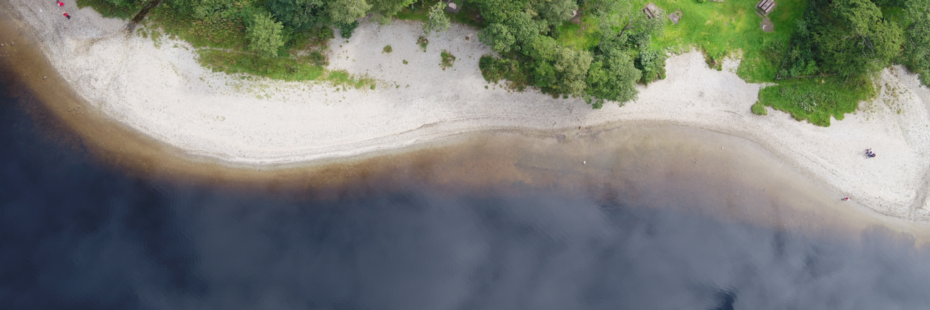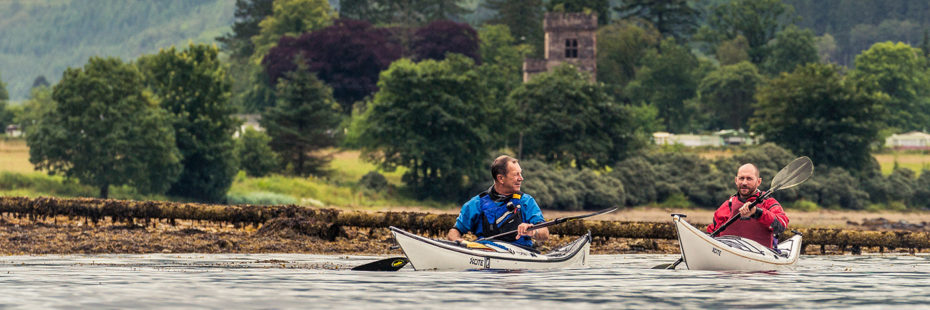
How to enjoy the water safely
Getting out and active on or near the water is a great way to enjoy and experience the National Park but whether you are an experienced open water swimmer or just fancy dipping your toes in to cool off, it’s essential that you’re well prepared before getting in the water.
Essential water safety advice

If you are intending to be in, on or near water please follow the water safety code, it’s available to download in the following languages:

Loch Lubnaig, credit: Turkey Red Media
The dark areas in the above image show steep, sudden drops close to shore.
- People can get into difficulty even in shallow water. Never go into the water alone and always keep a close eye on friends and family, particularly young children.
- The water in lochs can change depth suddenly and unexpectedly, sometimes very close to shore with steep drops. It’s best to stick to places you already know or find out as much as you can about an area before you get in the water.
- Always stay within your own capabilities and check the depth of the water bed by walking in carefully – if you can’t swim or are not an experienced swimmer then don’t paddle far from the shore as water depth can change suddenly.
- Even on a hot day the water is still very cold, Cold Water Shock can be life threatening even for experienced swimmers. It can set in quickly and rapidly lead to hypothermia. Enter slowly so you have time to get used to it.
- Avoid blue/green algae during the summer months.
- Stay sober – alcohol and water don’t mix well. Alcohol and drugs can have an impact on your swimming ability, body temperature and judgement.
- Avoid jumping or diving straight into the water. As well as the shock of the cold water there is a risk of unseen hazards under the water.
- If you do get into trouble in the water then float on your back and try not to panic. Follow the RNLI’s ‘Float to live’ advice:
- Always take a few minutes to check on site for any signs warning you of dangers in that area and public rescue equipment (PRE).
- Make sure you know where you are and have a note of your location in case you need to tell the emergency services.
- To help you locate exactly where you are, the What3Words app generates a unique combination of three words to describe every 3 square metres across the world. Download the app and use it to provide you with a three word reference for where you are which can be passed to the emergency services to help them locate you quickly and easily (for example, Duncan Mills Slipway = galaxy.rooting.amphibian)
- On Loch Lomond we are very fortunate to have a volunteer operated rescue boat. Always know where you are so help can get to you as quickly as possible should you need it.
-
In an emergency call 999, ask for Police and provide the exact location of the emergency.
Additional advice for recreational users

- If you are on a paddle board or kayak always wear a buoyancy aid. On Loch Lomond byelaws are in place which state you must have a buoyancy aid on board, if not you may be asked to return to shore.
- We strongly recommend you wear a wetsuit to keep you warmer and more buoyant.
- Tell someone where you are going and when you expect to be back.
- Remember that lochs can be busy and although you may be able to see boaters, they may not be able to see you! If swimming wear a bright swim cap and tow a bright float so you are more obvious to other loch users.
- Check weather conditions before heading out and remember that conditions can change quickly – a large swell can quickly develop when wind directions change.
- Be aware boaters may be in any area of the loch at any time of day or night. If possible avoid mooring areas, marinas and jetties used by boats, waterbus routes and boating channels.
- Look out for boats displaying an orange ball, this signifies ‘trolling’ which means fishing by trailing a lure or baited line along behind a Vessel. Keep clear to avoid the fishing lines.
- When swimming in open water, there is a risk that you may develop a rash or itch known as Swimmer’s Itch (Cercarial Dermatitis). Find out more about this on our Swimming page.
If you are planning any activity on Loch Lomond, please be aware of the Loch Lomond Byelaws.
National Park Rangers will be happy to answer any questions you might have – contact the Duncan Mills Memorial Slipway in Balloch on 01389 722030.
You can also find lots of helpful advice on the websites listed below:
- Water Safety Scotland Code
- Scottish Fire & Rescue Service
- RNLI – Know the Risks
- RNLI – Respect the Water

